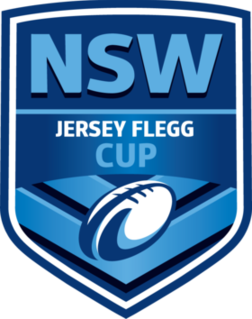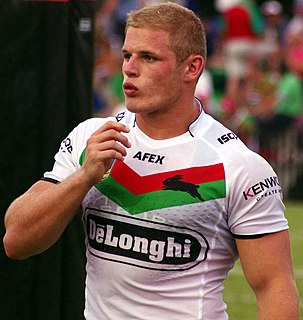
The South Sydney Rabbitohs are a professional Australian rugby league club based in Redfern, a suburb of inner-southern Sydney, New South Wales. They participate in the National Rugby League (NRL) premiership and are one of nine existing teams from the state capital, Sydney. They are often called Souths or The Bunnies.

Sydney Uni Rugby League Club is a rugby league team currently playing in the Saturday Metro League competition. The University of Sydney was represented in the New South Wales Rugby Football League premiership from 1920–1937 as University, and also in the NSWRL Second Division and Metropolitan League competitions from 1963 to 1976.
The New South Wales Rugby League premiership was the first rugby league football club competition established in Australia and contributor to today's National Rugby League. Run by the New South Wales Rugby League from 1908 until 1994, the premiership was the state's elite rugby league competition, parallel to Queensland's first-class league, the Brisbane Rugby League.
The NSW Cup, currently known as the Knock-On Effect NSW Cup for sponsorship reasons, is a rugby league competition for clubs in New South Wales. The competition has a history dating back to the NSWRFL's origins in 1908, starting off as a reserve grade competition, and is now the premier open age competition in the state. The NSW Cup was the Reserve Grade/Presidents Cup/First Division from 1908 until 2002, and the NSWRL Premier League from 2003 to 2007, the New South Wales Cup from 2008 to 2015, the Intrust Super Premiership NSW from 2016 to 2018, the Canterbury Cup NSW from 2019 to 2020. The New South Wales Cup, along with the Queensland Cup, acts as a feeder competition to the National Rugby League premiership.
Johnny Cecil King is an Australian former rugby league footballer and coach. He was a winger with the St. George Dragons for the last seven years of their eleven consecutive premiership-winning run from 1956 to 1966. He was a representative in the Australian national team from 1966 to 1970, earning 15 Test caps. He has been named among the nation's finest footballers of the 20th century.
The 1909 New South Wales Rugby Football League premiership was the second season of Sydney's top-level rugby league football competition, Australia's first. Eight teams contested during the season for the premiership and the Royal Agricultural Society Challenge Shield; seven teams from Sydney and one team from Newcastle, New South Wales.
The history of the South Sydney Rabbitohs rugby league football club stretches back to the pre-schism (1908) days of rugby football in Australia to the present. The club's history is one of the longest of any Australian rugby league club and they are one of the National Rugby League's last two extant foundation clubs along with the Sydney Roosters.
The Clayton Cup is a trophy that was awarded by the Country Rugby League to the NSW country rugby league team with the best overall record for that season. To be eligible, the team must win the highest level of competition in its region. Usually the winner of the Clayton Cup goes through the season undefeated. In late 2019, the Country Rugby League was absorbed by the New South Wales Rugby League.

The Jersey Flegg Cup is a junior rugby league competition played in New South Wales, contested among teams made up of players aged 21 or under. The competition is administered by the New South Wales Rugby League (NSWRL), and is named for Eastern Suburbs foundation player and prominent administrator of the game, Harry "Jersey" Flegg.

The S. G. Ball Cup is a junior rugby league football competition played predominantly in New South Wales, between teams made up of players aged under 19. Teams from Canberra and Melbourne also participate. Prior to the COVID-19 pandemic in New South Wales teams from Perth and Auckland also participated. The competition is administered by the New South Wales Rugby League. The competition includes both junior representative teams of NRL and NSW Cup clubs that do not field a team in the NRL competition.

The NSWRL Harold Matthews Cup is a junior rugby league competition played in New South Wales between teams made up of players aged under 16. The competition is administered by the New South Wales Rugby League (NSWRL). The competition is made up of NSW-based clubs and includes both junior representative teams of the elite National Rugby League (NRL) and clubs that do not field teams in the NRL competition.

The Wentworthville Magpies, colloquially known as Wenty, are a rugby league team based in the suburb of Wentworthville in Sydney's Western Suburbs. Founded in 1963, the club has competed in various Sydney district competitions and, since 2003, the semi-professional Ron Massey Cup and Sydney Shield competitions in NSW, Australia. The club also fielded a team in the Canterbury Cup NSW as part of a joint-venture with the Parramatta Eels between 2008 and 2019 acting as Parramatta's feeder club.
The Country New South Wales rugby league team is a representative rugby league football team. Between 1987 and 2017 there were two tiers: the Origin team that consisted of professional players who originated from clubs of the Country Rugby League and a representative team of amateur and semi-professional players. The Country Origin team played annually in the City vs Country Origin competition against the City New South Wales rugby league team, which was made up of players originating from Sydney. This match was discontinued in 2017.

George Burgess is an English professional rugby league footballer who plays as a prop for the St George Illawarra Dragons in the NRL.
The 1951 French rugby league tour of Australia and New Zealand was the first ever tour of Australasia by any French sports team in history. Puig Aubert captained the France national rugby league team who played 28 matches in total in both Australia and New Zealand, winning 21 of them in what is regarded as the high point in the history of rugby league in France. The Australian Test series resulted in a 2–1 victory to France; however, the tourists then lost their match against the New Zealand national rugby league team. Welcoming the team home to Marseille, more than 150,000 people turned out for a street parade.
The 1952 South Sydney DRLFC season was the 45th in the club's history. They competed in the New South Wales Rugby Football League's 1952 Premiership, and lost the grand final against the Western Suburbs.
Darren Brown is an Australian former professional rugby league footballer who played for the South Sydney Rabbitohs, Canterbury-Bankstown Bulldogs, Western Suburbs Magpies and the Penrith Panthers. Brown also played for Trafford Borough in England and for the Salford City Reds in the Super League. He spent most of his career as a lock or second rower, but could also play in the backline.
The 1954 Great Britain Lions tour was a tour by the Great Britain national rugby league team of Australia and New Zealand which took place between May and August 1954. Captained by Dickie Williams, the tour involved a schedule of 32 games: 22 in Australia and 10 in New Zealand, with two three-match Test Series against both nations.
The tour began inauspiciously, with Great Britain losing four of their first seven matches, including the First Test against Australia in Sydney. Moving into the Queensland leg, the Lions’ results improved, and they won all nine of their matches in the state. This included victory in the Second Test in Brisbane.
A common feature of many of the tour matches was rough play, punches being throw in and out of tackles. The July 10 match against New South Wales was abandoned by the referee seventeen minutes into the second half due to persistent brawling by the players.
One week after the abandoned game, Australia won the Third Test to claim the Ashes by a 2-1 margin.
Moving to New Zealand, Great Britain lost the Second Test, but recovered to win the Third Test and the series, by a 2-1 margin.
The tour concluded with three matches in five days back in Australia at Sydney, Canberra and Maitland.
Despite being a British team – five of the squad were Welsh, two from Scotland and hooker Tom McKinney from Northern Ireland – the team played, and were often referred to by both the press at home and away, as England.
The 1952–53 Kangaroo tour was the eighth Kangaroo tour, in which the Australian national rugby league team travelled to Great Britain and France and played forty matches, including the Ashes series of three Test matches against Great Britain and three Test matches against the French. It followed the tour of 1948-49 and the next was staged in 1956-57.
The 1948–49 Kangaroo tour was the seventh Kangaroo tour, in which the Australian national rugby league team travelled to Great Britain and France and played thirty-seven matches, including the Ashes series of three Test matches against Great Britain, an international match against Wales and two Test matches against the French. It followed the tour of 1937-38 and a cessation of overseas international tours due to World War II. The next was staged in 1952-53.






